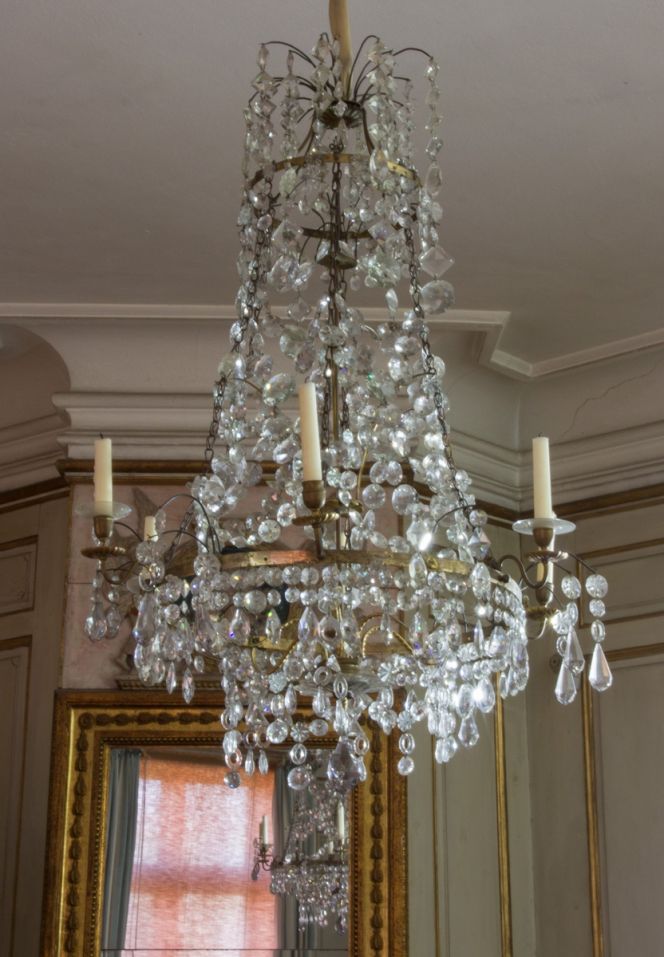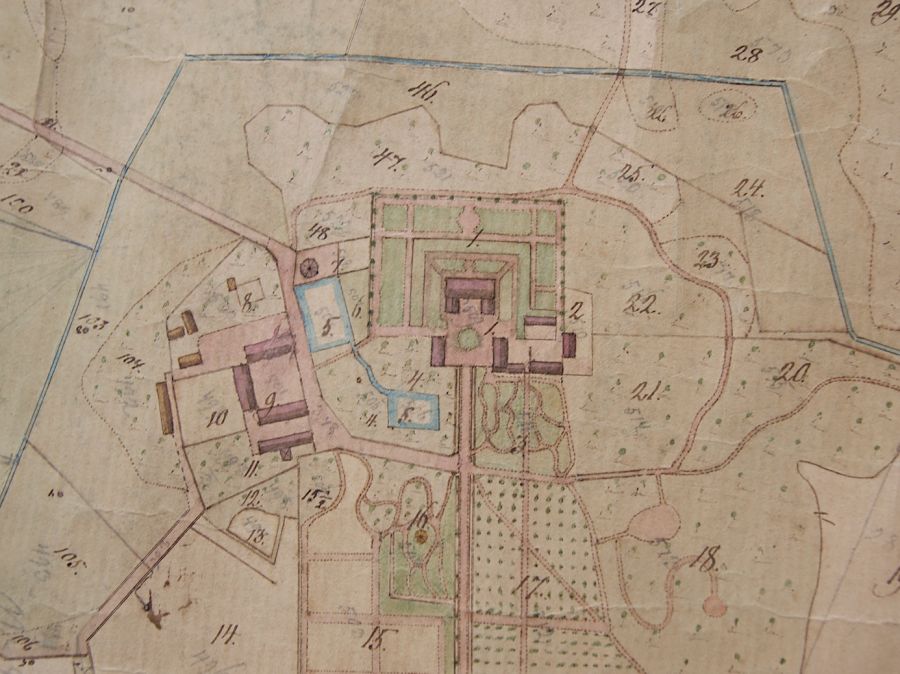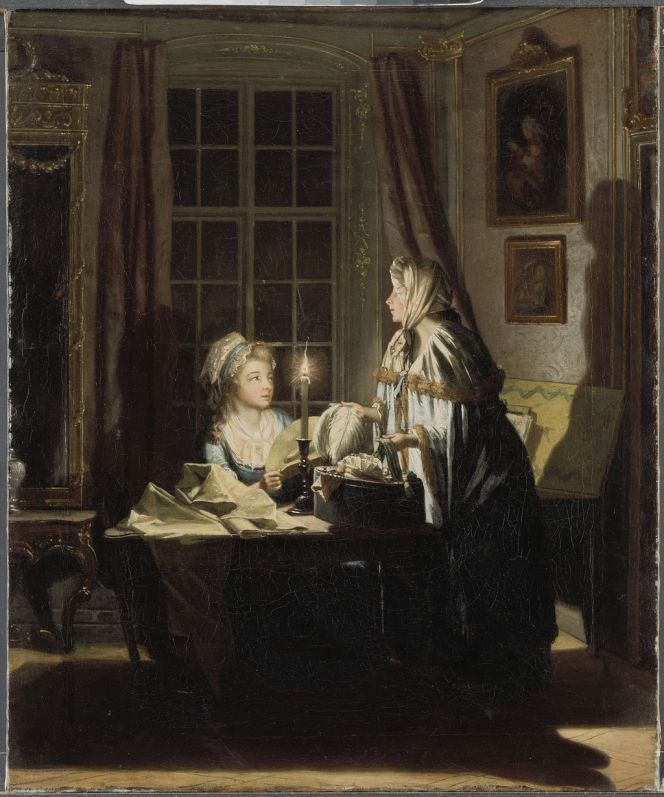ikfoundation.org
The IK Foundation
Promoting Natural & Cultural History
Since 1988


CANDELABRAS, CHANDELIERS AND MIRRORS WITH TEXTILE COVERS
– at a Manor House in 1758
In this fifth study from one of my earlier projects – about an 18th century Inventory from Christinehof Manor House in southernmost Sweden – fabrics covering candelabras, chandeliers and mirrors will be in focus. In the large Hall on the second floor, for instance, ’12 English cut mirror sconces with single candle holders and gilded frames with multum covers’ were listed. Such imported goods of English or French origin were mentioned on several occasions, giving evidence for the aristocratic family’s high standard of living and the possibility of owning desired luxury wares for their home interior. It was not only woollen cloth that protected the valuable pieces, but yellow damask and linen qualities were also mentioned in the inventory from 1758.
![The woollen cloth covers protected the fine mirrors, chandeliers etc from dust and soot, but covers were also useful in periods when the house was uninhabited or during long bright summer days. This type of woollen quality – called multum or molton in 18th century Sweden: a kind of coarse twill or tabby woven fabric, in one colour or stripes, napped on one or two sides to be soft – was woven at Josias Hegard’s woollen manufacturer in Malmö, ca 100 kilometres from Christinehof. However, if the fabrics were purchased here or via one of the woollen manufacturers in Stockholm or imported from France or elsewhere is unknown. Comparable with a few samples of such [and similar] woollen cloths from Rouen, Beauvais and Languedoc, ca 1740-60s – also named “molton” in French. (Courtesy of: Nordic Museum, Stockholm, Sweden. Anders Berch Collection. Digitalt Museum Image, no. 17648b:4).](https://www.ikfoundation.org/uploads/image/1-nm17648b4-nordic-museum-900x591.jpg) The woollen cloth covers protected the fine mirrors, chandeliers etc from dust and soot, but covers were also useful in periods when the house was uninhabited or during long bright summer days. This type of woollen quality – called multum or molton in 18th century Sweden: a kind of coarse twill or tabby woven fabric, in one colour or stripes, napped on one or two sides to be soft – was woven at Josias Hegard’s woollen manufacturer in Malmö, ca 100 kilometres from Christinehof. However, if the fabrics were purchased here or via one of the woollen manufacturers in Stockholm or imported from France or elsewhere is unknown. Comparable with a few samples of such [and similar] woollen cloths from Rouen, Beauvais and Languedoc, ca 1740-60s – also named “molton” in French. (Courtesy of: Nordic Museum, Stockholm, Sweden. Anders Berch Collection. Digitalt Museum Image, no. 17648b:4).
The woollen cloth covers protected the fine mirrors, chandeliers etc from dust and soot, but covers were also useful in periods when the house was uninhabited or during long bright summer days. This type of woollen quality – called multum or molton in 18th century Sweden: a kind of coarse twill or tabby woven fabric, in one colour or stripes, napped on one or two sides to be soft – was woven at Josias Hegard’s woollen manufacturer in Malmö, ca 100 kilometres from Christinehof. However, if the fabrics were purchased here or via one of the woollen manufacturers in Stockholm or imported from France or elsewhere is unknown. Comparable with a few samples of such [and similar] woollen cloths from Rouen, Beauvais and Languedoc, ca 1740-60s – also named “molton” in French. (Courtesy of: Nordic Museum, Stockholm, Sweden. Anders Berch Collection. Digitalt Museum Image, no. 17648b:4).The large Hall on the second floor could not only be illuminated by the twelve mirror sconces mentioned in the introduction, as it additionally was listed as ‘1 large carved gilded candelabra lined with yellow damask fabric, and a covering of the whole candelabra with a yellow linen cover.’ To line or decorate a candelabra with cloth of various sorts seems, according to today’s health and safety, an exceptional fire hazard, but this was in no way unique to this wealthy household. Åkerö Manor House, situated somewhat north of the capital – owned by Count Carl Gustaf Tessin – was where a similar Inventory was made up in 1757. In one dining hall were, for example, listed: ‘…in the ceiling hung two crystal chandeliers of Bohemian origin, whose ropes were lined with red taffeta. In the summer, covered with a fabric of the same quality’ (Selling… p. 126).
 This crystal chandelier with holders for six candles shows similarities – even if larger in size – with a listed model in the inventory. Such a fine piece was added to the Christinehof interior on the first floor according to a note written in 1765: ‘One small chandelier with six holders of cut crystal and gilded mountings’. Other candle-holders were placed on the walls, present on the same floor already in 1758, for instance: ‘8 mirror sconces with double candle-holders and gilded frames and multum covers’. It seems to have been a general rule to protect the valuable chandeliers and mirrors when not in use, judging by several notes of this kind in the inventory. (Courtesy of: Nordic Museum, Stockholm, Sweden. Skanm.0068103. Digitalt Museum).
This crystal chandelier with holders for six candles shows similarities – even if larger in size – with a listed model in the inventory. Such a fine piece was added to the Christinehof interior on the first floor according to a note written in 1765: ‘One small chandelier with six holders of cut crystal and gilded mountings’. Other candle-holders were placed on the walls, present on the same floor already in 1758, for instance: ‘8 mirror sconces with double candle-holders and gilded frames and multum covers’. It seems to have been a general rule to protect the valuable chandeliers and mirrors when not in use, judging by several notes of this kind in the inventory. (Courtesy of: Nordic Museum, Stockholm, Sweden. Skanm.0068103. Digitalt Museum). Map of Christinehof manor house and surrounding areas ca 100 years after the 1758 inventory was written. The sizes of fields and some meandering gardens had changed, but the main building and the formal garden close to the house were much the same as in the mid-18th century. The very same for the straight road which brought the family to and fro one of their other homes – for instance on the ca 500 kilometre journey to Stockholm in a horse-drawn carriage on public highways taking about five to seven days. However, it is likely that one paid visits at friends’ or relatives’ homes, which prolonged the journey even further. (Courtesy of: Historical Archive of Högestad and Christinehof, The Main Archive, part of an 1864 map). Photo: The IK Foundation, London.
Map of Christinehof manor house and surrounding areas ca 100 years after the 1758 inventory was written. The sizes of fields and some meandering gardens had changed, but the main building and the formal garden close to the house were much the same as in the mid-18th century. The very same for the straight road which brought the family to and fro one of their other homes – for instance on the ca 500 kilometre journey to Stockholm in a horse-drawn carriage on public highways taking about five to seven days. However, it is likely that one paid visits at friends’ or relatives’ homes, which prolonged the journey even further. (Courtesy of: Historical Archive of Högestad and Christinehof, The Main Archive, part of an 1864 map). Photo: The IK Foundation, London.The interior of Christinehof Manor House also included two gilded mirrors of English make, one mentioned as ‘with its cover over’. Other models (5) were described ‘as large and high mirrors with multum covers’, made of more than one piece of glass. A few of these expensive mirror glasses were designed with ornamentally carved and gilded mirror frames. However, the manufacturing of mirrors and regular trade included not only imported goods; the extensive Stockholm market gives examples of these matters. Among others, Olof Westerberg was a master in his guild since 1740, and the Frenchman Jean Caspar Callion also worked as a mirror maker in the Swedish capital. Only on one street alone – Västerlånggatan – three mirror shops existed after 1750, and furthermore, several furniture shops sold mirrors.
It could also be assumed that some of the mirrors with woollen covers originated from one or both of these two professionals, as the mirror manufacturers were mentioned in several letters from the son Carl Gustaf to his father, Carl Fredrik Piper. The son, who lived in Stockholm, assisted the father with orders for such goods while he stayed at Christinehof or one of the family’s other manor houses outside the capital. Judging by the correspondence, various difficulties seem to have been quite common when large-sized mirrors were produced, so the wealthy customers in the 1760s needed patience for such purchases. It may also be noted that a complex network of family members’ correspondence, various inventory lists, recipes and accounts reveal rich details of 18th century everyday life as well as luxury consumerism, such as these mirrors – all linked to the urban, rural and domestic sphere alike.
 A somewhat later 18th century depiction of an aristocratic home, demonstrates the importance of a single candle light in its holder and the large gilded mirror design, both items included in the Christinehof inventory of 1758. The artist Pehr Hilleström (1732-1816) first and foremost focused on how the lady of the house in convenience may choose from various hat models and fabric, which could be ordered via her milliner without visiting shops for the latest fashion. Judging by the milliner’s fur-edged cloak and the compact darkness – it must have been winter. However, the darkness illustrated in this painting must have been less of an obstacle for the daily activities of the Piper family at Christinehof, as the house primarily was in use as a residence in summer and early autumn months. (Courtesy of: National Museum, Sweden. NM 3382. Wikimedia Commons).
A somewhat later 18th century depiction of an aristocratic home, demonstrates the importance of a single candle light in its holder and the large gilded mirror design, both items included in the Christinehof inventory of 1758. The artist Pehr Hilleström (1732-1816) first and foremost focused on how the lady of the house in convenience may choose from various hat models and fabric, which could be ordered via her milliner without visiting shops for the latest fashion. Judging by the milliner’s fur-edged cloak and the compact darkness – it must have been winter. However, the darkness illustrated in this painting must have been less of an obstacle for the daily activities of the Piper family at Christinehof, as the house primarily was in use as a residence in summer and early autumn months. (Courtesy of: National Museum, Sweden. NM 3382. Wikimedia Commons).The manor house also included a variation of smaller mirrors and simpler light sources – like candle holders of wood or metal that could be moved from one room to another – but with no particular connection to textile materials.
Notice: Quotes are translated from Swedish to English. A large number of primary and secondary sources were used for this essay. For a full Bibliography & information about the project, please see Viveka Hansen’s book, 2004 (pp. 15-17 & 38-62).
Sources:
- Hansen, Viveka, Inventariüm uppå meübler och allehanda hüüsgeråd sid Christinehofs Herregård upprättade åhr 1758, Piperska Handlingar No. 2, London & Whitby 2004.
- Hansen, Viveka, Katalog över Högestads & Christinehofs Fideikommiss, Historiska Arkiv, Piperska Handlingar No. 3, London & Christinehof 2016.
- Historical Archive of Högestad and Christinehof (Piper Family Archive, no D/Ia & J/10 137).
- Selling, Gösta, Svenska Herrgårdshem under 1700-talet, Stockholm 1937.
- Stavenow-Hidemark, Elisabet, 1700-tals Textil – 18th Century Textile, Stockholm 1990.
Essays
The iTEXTILIS is a division of The IK Workshop Society – a global and unique forum for all those interested in Natural & Cultural History from a textile Perspective.
Open Access essays, licensed under Creative Commons and freely accessible, by Textile historian Viveka Hansen, aim to integrate her current research, printed monographs, and earlier projects dating back to the late 1980s. Some essays feature rare archive material originally published in other languages, now available in English for the first time, revealing aspects of history that were previously little known outside northern European countries. Her work also explores various topics, including the textile trade, material culture, cloth manufacturing, fashion, natural dyeing, and the intriguing world of early travelling naturalists – such as the "Linnaean network" – viewed through a global historical lens.
For regular updates and to fully utilise iTEXTILIS' features, we recommend subscribing to our newsletter, iMESSENGER.
been copied to your clipboard




– a truly European organisation since 1988
Legal issues | Forget me | and much more...
You are welcome to use the information and knowledge from
The IK Workshop Society, as long as you follow a few simple rules.
LEARN MORE & I AGREE







